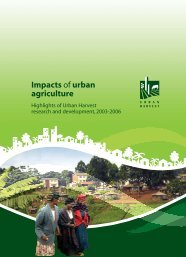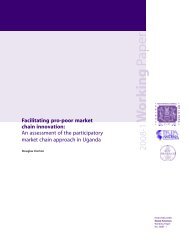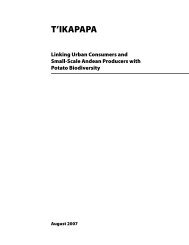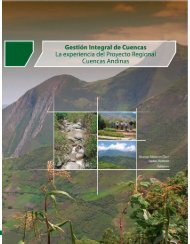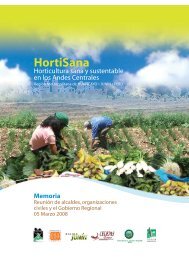Download pdf - International Potato Center
Download pdf - International Potato Center
Download pdf - International Potato Center
You also want an ePaper? Increase the reach of your titles
YUMPU automatically turns print PDFs into web optimized ePapers that Google loves.
CIP • SOCIAL SCIENCES WORKING PAPER 2010-1<br />
the post-harvest loss of potato is estimated at 30-50%. This prompted research to improve the<br />
productivity and reduce post-harvest loss of potato. As a result, several improved varieties and<br />
associated post-harvest handling techniques have been generated, and productivity has<br />
improved to as high as 25 to 40 t/ha. This could lead to an increase in the national annual<br />
production of potato of between 4.0 and 6.4 million tonnes. The study has also indicated that<br />
potato is one of the most important sources of on-farm incomes for the farmers in Ethiopia. In<br />
areas where there is relatively good market infrastructure, potato has become the leading cash<br />
crop and one of the most important food security crops to farmers. One of the major problems in<br />
potato marketing was low prices offered for ware potato. This was because consumption of<br />
potato is not diversified. This suggests the need for assessing chips processing sub-sector and the<br />
potential of expanding the market both domestically and regionally.<br />
According to potato production and marketing study in Kenya by Okoboj (2001), annual<br />
production of potato in 1996 was about 499,000 metric tons. The study indicated that the author<br />
did not get any information concerning potato exports from Kenya to other countries in the<br />
region. However, it was unofficially estimated that about 10 trucks offload 40 feet trailer loads of<br />
potatoes weekly from Tanzania. This indicates that the demand for potato is high in Nairobi and<br />
the local supply deficit is supplemented by imports.<br />
According to FAO estimates (www.faostat.org), Kenya produced only 360,000 metric tons in 2000<br />
compared to 478,000 metric tons produced by Uganda. However, it is known that Kenya has a<br />
higher per capita consumption of potato products in urban areas than Uganda. All these statistics<br />
positively illustrate the possibility of expanding urban markets with processed potato products.<br />
There is limited formal and informal trade taking place along the Uganda-Rwanda border<br />
(Okoboj, 2001). The study identified potato chips as the most popular potato product in urban<br />
areas evidenced by the increasing number of fast food outlets. The study also indicated limited<br />
border traders. For instance, some traders import potato from Rwanda to Uganda through the<br />
Katuna border. <strong>Potato</strong> trade between Uganda and Rwanda exists informally along other smaller<br />
border crossings in Kabale and Kisoro, such as the Kyanika border. Some traders occasionally<br />
bring potatoes from eastern D. R. Congo. This evidence indicates the possibility of strengthening<br />
cross border trades to enhance the production and productivity of potato. Such existing practices<br />
could be strengthened through formal support to ensure the availability of potato as a raw<br />
material for chips processing industries.<br />
In general, evidence illustrates the considerable demand that exists for potatoes and potato chips<br />
in the world in general and in SSA countries in particular. Among the SSA sub-region, a large<br />
M A R K E T S F O R F R E S H A N D F R O Z E N P O T A T O C H I P S I N T H E E C A 5






